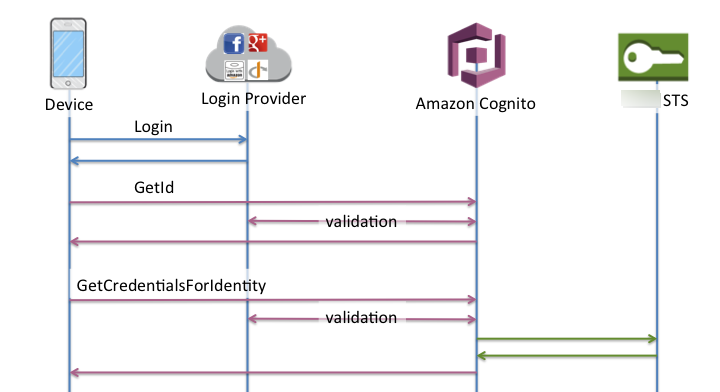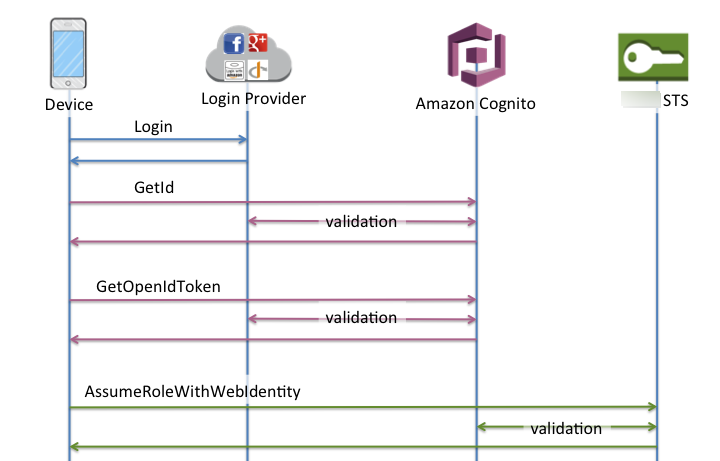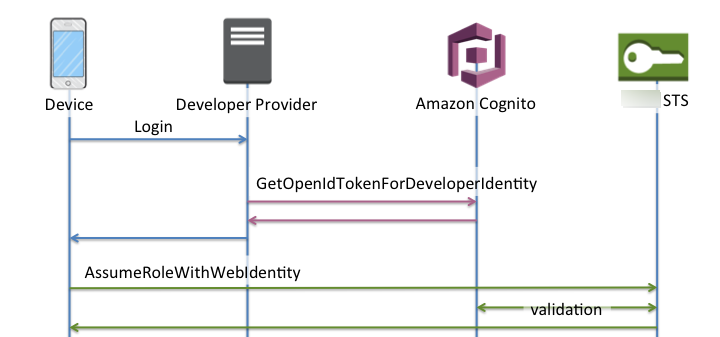Identity pools (federated identities) authentication flow
Amazon Cognito helps you create unique identifiers for your end users that are kept consistent across devices and platforms. Amazon Cognito also delivers temporary, limited-privilege credentials to your application to access Amazon resources. This page covers the basics of how authentication in Amazon Cognito works and explains the lifecycle of an identity inside your identity pool.
External provider authflow
A user authenticating with Amazon Cognito goes through a multi-step process to bootstrap their credentials. Amazon Cognito has two different flows for authentication with public providers: enhanced and basic.
Once you complete one of these flows, you can access other Amazon Web Services as defined
by your role's access policies. By default, the Amazon Cognito console
Identity pools accept the following artifacts from providers:
| Provider | Authentication artifact |
|---|---|
| Amazon Cognito user pool | ID token |
| OpenID Connect (OIDC) | ID token |
| SAML 2.0 | SAML assertion |
| Social provider | Access token |
Enhanced (simplified) authflow
When you use the enhanced authflow, your app first presents a proof of authentication from an authorized Amazon Cognito user pool or third-party identity provider in a GetId request.
-
Your application presents a proof of authentication–a JSON web token or a SAML assertion–from an authorized Amazon Cognito user pool or third-party identity provider in a GetID request.
-
Your identity pool returns an identity ID.
-
Your application combines the identity ID with the same proof of authentication in a GetCredentialsForIdentity request.
-
Your identity pool returns Amazon credentials.
-
Your application signs Amazon API requests with the temporary credentials.
Enhanced authentication manages the logic of IAM role selection and credentials retrieval in your identity pool configuration. You can configure your identity pool to select a default role, to to apply attribute-based access control (ABAC) or role-based access control (RBAC) principles to role selection. The Amazon credentials from enhanced authentication are valid for one hour.
Order of operations in Enhanced authentication
-
GetId -
GetCredentialsForIdentity

Basic (classic) authflow
When you use the basic authflow,
-
Your application presents a proof of authentication–a JSON web token or a SAML assertion–from an authorized Amazon Cognito user pool or third-party identity provider in a GetID request.
-
Your identity pool returns an identity ID.
-
Your application combines the identity ID with the same proof of authentication in a GetOpenIdToken request.
-
GetOpenIdTokenreturns a new OAuth 2.0 token that is issued by your identity pool. -
Your application presents the new token in an AssumeRoleWithWebIdentity request.
-
Amazon Security Token Service Amazon STS) returns Amazon credentials.
-
Your application signs Amazon API requests with the temporary credentials.
The basic workflow gives you more granular control over the credentials that you
distribute to your users. The GetCredentialsForIdentity request of the
enhanced authflow requests a role based on the contents of an access token. The
AssumeRoleWithWebIdentity request in the classic workflow grants your
app a greater ability to request credentials for any Amazon Identity and Access Management role that you have
configured with a sufficient trust policy. You can also request a custom role session
duration.
Order of operations in Basic authentication
-
GetId -
GetOpenIdToken -
AssumeRoleWithWebIdentity

Developer authenticated identities authflow
When using Developer-authenticated identities (identity pools), the client uses a different authflow that includes code outside of Amazon Cognito to validate the user in your own authentication system. Code outside of Amazon Cognito is indicated as such.
Enhanced authflow
Order of operations in Enhanced authentication with a developer provider
-
Login via Developer Provider (code outside of Amazon Cognito)
-
Validate the user login (code outside of Amazon Cognito)

Order of operations in Basic authentication with a developer provider
-
Implement logic outside of identity pool to sign in and generate a developer-provider identifier.
-
Retrieve stored server-side Amazon credentials.
-
Send developer provider identifier in a GetOpenIdTokenForDeveloperIdentity API request signed with authorized Amazon credentials.
-
Request application credentials with AssumeRoleWithWebIdentity.

Which authflow should I use?
The enhanced flow is the most secure choice with the lowest level of developer effort:
-
The enhanced flow reduces the complexity, size, and rate of API requests.
-
Your application doesn't need to make additional API requests to Amazon STS.
-
Your identity pool evaluates your users for the IAM role credentials that they should receive. You don't need to embed logic for role selection in your client.
Important
When you create a new identity pool, don't activate basic (classic) authentication by default, as a best practice. To implement basic authentication, first evaluate the trust relationships of your IAM roles for web identities. Then build the logic for role selection into your client and secure the client against modification by users.
The basic authentication flow delegates the logic of
IAM role selection to your application. In this flow, Amazon Cognito validates your user's
authenticated or unauthenticated session and issues a token that you can exchange for
credentials with Amazon STS. Users can exchange the tokens from basic authentication for any
IAM roles that trust your identity pool and amr, or
authenticated/unauthenticated state.
Similarly, understand that developer authentication is a shortcut around validation of identity provider authentication. Amazon Cognito trusts the Amazon credentials that authorize a GetOpenIdTokenForDeveloperIdentity request without additional validation of the request contents. Secure the secrets that authorize developer authentication from access by users.
API summary
- GetId
-
The GetId API call is the first call necessary to establish a new identity in Amazon Cognito.
- Unauthenticated access
-
Amazon Cognito can grant unauthenticated guest access in your applications. If this feature is enabled in your identity pool, users can request a new identity ID at any time via the
GetIdAPI. The application is expected to cache this identity ID to make subsequent calls to Amazon Cognito. The Amazon Mobile SDKs and the Amazon SDK for JavaScript in the Browser have credentials providers that handle this caching for you. - Authenticated access
-
When you've configured your application with support for a public login provider (Facebook, Google+, Login with Amazon, or Sign in with Apple), users can also supply tokens (OAuth or OpenID Connect) that identify them in those providers. When used in a call to
GetId, Amazon Cognito creates a new authenticated identity or returns the identity already associated with that particular login. Amazon Cognito does this by validating the token with the provider and making sure of the following:-
The token is valid and from the configured provider.
-
The token is not expired.
-
The token matches the application identifier created with that provider (for example, Facebook app ID).
-
The token matches the user identifier.
-
- GetCredentialsForIdentity
-
The GetCredentialsForIdentity API can be called after you establish an identity ID. This operation is functionally equivalent to calling GetOpenIdToken, then AssumeRoleWithWebIdentity.
For Amazon Cognito to call
AssumeRoleWithWebIdentityon your behalf, your identity pool must have IAM roles associated with it. You can do this via the Amazon Cognito console or manually via the SetIdentityPoolRoles operation. - GetOpenIdToken
-
Make a GetOpenIdToken API request after you establish an identity ID. Cache identity IDs after your first request, and start subsequent basic (classic) sessions for that identity with
GetOpenIdToken.The response to a
GetOpenIdTokenAPI request is a token that Amazon Cognito generates. You can submit this token as theWebIdentityTokenparameter in an AssumeRoleWithWebIdentity request.Before you submit the OpenID token, verify it in your app. You can use OIDC libraries in your SDK or a library like aws-jwt-verify
to confirm that Amazon Cognito issued the token. The signing key ID, or kid, of the OpenID token is one of those listed in the Amazon Cognito Identity jwks_uri document†. These keys are subject to change. Your function that verifies Amazon Cognito Identity tokens should periodically update its list of keys from the jwks_uri document. Amazon Cognito sets the refresh duration in the jwks_uri cache-control response header, currently set to a max-ageof 30 days.- Unauthenticated access
-
To obtain a token for an unauthenticated identity, you only need the identity ID itself. It is not possible to get an unauthenticated token for authenticated identities or identities that you have deactivated.
- Authenticated access
-
If you have an authenticated identity, you must pass at least one valid token for a login already associated with that identity. All tokens passed in during the
GetOpenIdTokencall must pass the same validation mentioned earlier; if any of the tokens fail, the whole call fails. The response from theGetOpenIdTokencall also includes the identity ID. This is because the identity ID that you pass in may not be the one that is returned. - Linking logins
-
If you submit a token for a login that is not already associated with any identity, the login is considered to be "linked" to the associated identity. You may only link one login per public provider. Attempts to link more than one login with a public provider results in a
ResourceConflictExceptionerror response. If a login is merely linked to an existing identity, the identity ID returned fromGetOpenIdTokenis the same as the one that you passed in. - Merging identities
-
If you pass in a token for a login that is not currently linked to the given identity, but is linked to another identity, the two identities are merged. Once merged, one identity becomes the parent/owner of all associated logins and the other is disabled. In this case, the identity ID of the parent/owner is returned. You must update your local cache if this value differs. The providers in the Amazon Mobile SDKs or Amazon SDK for JavaScript in the Browser perform this operation for you.
- GetOpenIdTokenForDeveloperIdentity
-
The GetOpenIdTokenForDeveloperIdentity operation replaces the use of GetId and GetOpenIdToken from the device when using developer authenticated identities. Because your application signs requests to this API operation with Amazon credentials, Amazon Cognito trusts that the user identifier supplied in the request is valid. Developer authentication replaces the token validation that Amazon Cognito performs with external providers.
The payload for this API includes a
loginsmap. This map must contain the key of your developer provider and a value as an identifier for the user in your system. If the user identifier isn't already linked to an existing identity, Amazon Cognito creates a new identity and returns the new identity ID and an OpenID Connect token for that identity. If the user identifier is already linked, Amazon Cognito returns the pre-existing identity ID and an OpenID Connect token. Cache developer identity IDs after your first request, and start subsequent basic (classic) sessions for that identity withGetOpenIdTokenForDeveloperIdentity.The response to a
GetOpenIdTokenForDeveloperIdentityAPI request is a token that Amazon Cognito generates. You can submit this token as theWebIdentityTokenparameter in anAssumeRoleWithWebIdentityrequest.Before you submit the OpenID Connect token, verify it in your app. You can use OIDC libraries in your SDK or a library like aws-jwt-verify
to confirm that Amazon Cognito issued the token. The signing key ID, or kid, of the OpenID Connect token is one of those listed in the Amazon Cognito Identity jwks_uri document†. These keys are subject to change. Your function that verifies Amazon Cognito Identity tokens should periodically update its list of keys from the jwks_uri document. Amazon Cognito sets the refresh duration in the jwks_uri cache-controlresponse header, currently set to amax-ageof 30 days.- Linking logins
-
As with external providers, supplying additional logins that are not already associated with an identity implicitly links those logins to that identity. If you link an external provider login to an identity, the user can use the external provider authflow with that provider. However, they cannot use your developer provider name in the logins map when calling
GetIdorGetOpenIdToken. - Merging identities
-
With developer authenticated identities, Amazon Cognito supports both implicit merging and explicit merging through the MergeDeveloperIdentities API. With explicit merging, you can mark two identities with user identifiers in your system as a single identity. If you supply the source and destination user identifiers, Amazon Cognito merges them. The next time you request an OpenID Connect token for either user identifier, the same identity id is returned.
- AssumeRoleWithWebIdentity
-
After you have an OpenID Connect token, you can then trade this for temporary Amazon credentials through the AssumeRoleWithWebIdentity API request to Amazon Security Token Service (Amazon STS).
Because there is no restriction on the number of identities that you can create, it is important to understand the permissions that you're granting to your users. Set up different IAM roles for your application: one for unauthenticated users, and one for authenticated users. The Amazon Cognito console can create default roles when you first set up your identity pool. These roles have effectively no permissions granted. Modify them to meet your needs.
Learn more about Role trust and permissions.
† The default Amazon Cognito Identity jwks_uri
| Amazon Web Services Region | Path to jwks_uri document |
|---|---|
| Amazon GovCloud (US-West) | https://cognito-identity.us-gov-west-1.amazonaws.com/.well-known/jwks_uri |
| China (Beijing) | https://cognito-identity.cn-north-1.amazonaws.com.cn/.well-known/jwks_uri |
| Opt-in Regions like Europe (Milan) and Africa (Cape Town) | https://cognito-identity. |
You can also extrapolate the jwks_uri from the
issuer or iss that you receive in the OpenID token from Amazon Cognito. The
OIDC-standard discovery endpoint
<issuer>/.well-known/openid-configuration lists a path to the
jwks_uri for your token.